The Grand Place complex was established in 1782 and it consists of not only the royal residence and throne halls, but also a number of government offices as well as the renowned Temple of the Emerald Buddha. It covers an area of 218,000 square metres and is surrounded by four walls, 1900 metres in length. Here is a guide to the Grand Palace.
The Grand Palace
After King Rama I ascended to the throne in 1782, the palace was built. Prior to this, the royal palace and centre of administration had been located in Thonburi, on the west side of the Chao Phraya River. For various reasons, the new king considered the former capital to be unsuitable and decided to establish a new capital on the other side of the river. By his royal command, a new palace was built to serve not only by his residence but also as the site of administrative offices. The royal compound has been known since then as the Grand Palace. The two earliest structures erected within the complex were the Dusit Maha Prasat Throne Hall, and the Phra Maha Monthian.
The Royal Monastery of the Emerald Buddha
North of the royal residence and linked by a connecting gateway lies the Royal Monastery of the Emerald Buddha, one of the most venerated sites in Thailand where people convene to pay respect to the Lord Buddha and his Teachings. The Emerald Buddha is enshrined on a golden traditional Thai-style throne made of gilded-carved wood, known as a Busabok, in the ordination hall of the royal monastery. The sacred image is clad with one of the three seasonal costumes (summer, rainy season, and winter). The costumes are changed three times a year in a ceremony presided over by His Majesty the King.
The Emerald Buddha is in fact carved from a block of green jade and was first discovered in 1434 in a stupa in Chiang Rai. At that time the image was covered with plaster and was thought to be an ordinary Buddha image. Later, however, the abbot who had found the image noticed that the plaster in the nose had flaked off, revealing the green stone underneath. The abbot initially thought that the stone was emerald and thus the legend of the Emerald Buddha image began.
The image was later taken to Lampang where it remained until King Tilok of Lannathai moved it to Chiang Mai, his capital where it was fittingly enshrined. In 1552 an interruption occurred in the Lannathai line of succession. King Chaichettha of Luang Prabang, who was the son of a Chiang Mai princess and a Laotian King, was invited to fill the gap. However, after a relatively short reign he returned to Laos to succeed his father’s throne, taking with him, the Emerald Buddha. The image remained in Laos fir 226 years until 1778 when a Thai army under the command of Chao Phraya Chakri, who later became King Rama I, captured Vientiane, the Laotian capital, and the image was brought back to Thailand. When King Rama I had established the city of Bangkok, the Emerald Buddha was housed within the Royal Monastery with due pomp and ceremony.
The Monastery consists of all the architectural features of a Buddhist monastery but without residential quarters as no monks reside here. It also serves as the monarch’s private chapel and, as such, the ordination hall is furnished with two partitions on either side of the main altar in order to provide a retiring room for the monarch. This feature is found only at the Royal Chapel of Thonburi, which now serves as the ordination hall of Wat Arun, located on the grounds of the palace of King Thonburi.
In front of the high altar, stand two large Buddha images. These were cast in 1841 by royal behest of King Rama III in dedication to his grandfather-King Rama I and his father-King Rama II. The images were named Phra Phuttha Yod Fa Chula Lok and Phra Phuttha Loetla Napalai. Another image, Samphutthapanni Buddha image, also highly venerated by the Thai people, is situated in from of the high altar. It was cast by King Mongkut (Rama IV) during the time he was ordained as a monk.
The walls of the ordination hall are decorated with mural paintings. Above the window frames, from the south west corner on the right of the altar, are a series of paintings depicting selected events of the Lord Buddha’s life, including scenes from his birth, childhood, youth and the Great Renunciation. The murals on the east wall facing the high altar portray scenes of Temptation and Enlightenment, with a picture of the Earth Goddess underneath the Buddha’s seat. The murals along the north wall demonstrate the Lord Buddha’s preaching his Dharma and his Entering Nirvana and those behind the main altar represent the Buddhist Cosmology. Those behind the window panels illustrate various scenes from Jataka stories and Thai proverbs.
The Upper Terrace
Four main monuments are found on this terrace: a reliquary in the shape of a golden chedi; the Mondop, a repository for Buddhist sacred scriptures inscribed on palm leaves, contained within a beautiful mother-of-pearl inlaid cabinet; a miniature Angkor Wat crafted by the order of King Mongkut (Rama IV); and the Royal Pantheon in which statues of past sovereigns of the ruling Chakri Dynasty are enshrined.
Scattered around the terrace are statues of elephants and mythical beings. The models of elephants are a record of the famous white elephants acquired during the reigns of the various king of Thailand.
Subsidiary Building
At ground level to the north of the upper terrace are three more buildings of interest, namely the Scripture Library (Hor Phra Monthian Dharma), the west façade of which is said to be the finest in Bangkok; a beautifully gabled wiharn (Phra Wiharn Yod) which contains a number of Buddha images; and the mausoleum if the Royal Family (Hor Phra Naga), which contains the crematorial ashes of a number of members of the royal family.
To the west of the ordination hall lie two small chapels, Hor Phra Rajphongsanusorn to the south and Hor Phra Rajkoramanusorn to the north. Hor Phra Rajkoramanusorn contains Buddha images dedicated to the past Kings of Ayuthaya, whereas Hor Phra Rajphongsanusorn contains images dedicated to the present dynasty. Hor Phra Rajkoramanusorn is also noteworthy for a number of murals accredited to the famous painter of the reign of Rama IV, Khrua in Khong. The murals are faded with age but this makes them all more aesthetic.
The Galleries
The grounds of the Royal Monastery are encompassed by the galleries, the walls of which are pained with scenes from the Ramakien, first painted during the reign of King Rama I and since then restored several times. The first scene of the story is found next to the east gate, just opposite Phra Wiharn Yod. There is a depiction of the initial stages of the war waged by Rama of Ayothaya to rescue his wife, SIta, who had been abducted by Thotsakan (Ravana), King of Longka. Further on there are a number of other episodes from the story: the building of the causeway from the mainland; the battle of Maiyarab, the Magician who took the sleeping Rama to the underworld; the battles of Kumpakan and Indrasit, the brother and son respectively of Thotsakan; and other battles waged by Thotsakan his other relatives and allies. The significant battle in which Thotsakan loses his life is to be found just near the gate leading to the Royal Palace.
The Phra Maha Monthian Group
This area consists of three main buildings, namely the Audience Hall of Amarindra Winitchai, the Paisal Taksin Hall, and the Chakraphat Phiman Hall.
The Audience Hall was built in 1785 during the reign of King Rama I. It is used for a number of state ceremonies such as the birthday anniversary of the King. The hall’s main feature is a throne which is surmounted by a nine-tiered white canopy, flanked by two seven-tiered white umbrellas and backed by a boat-shaped altar. The Paisal Taksin Hall is where the coronation ceremony takes place. It contains the octagonal seat on which the king is seated when receiving the invitation of the representative of the people to rule the kingdom, and also the Coronation Chair on which the king receives the accoutrements of office. In the centre, between two seats, is a high altar containing the nation’s tutelary deity figurem Phra Syam Thewathirat, or Phra Syam for short.
The Chakraphat Phiman building was the residence of Kings Rama I, Rama II, and Rama III. It has subsequently become customary for the sovereign to spend at least one night here after the coronation to signify the taking up of official residence. On either side of the door leading into the residence chamber are depictions of various seals of state including, among others, the Lion of the Ministry of Interior, the Elephantine Lion of the Ministry of Defense, and the Crystal Lotus of the Ministry of Foreign Affairs. The living apartments of the building are entered by mounting a series of steps into a hallway. To the left of the hallway (the east side) is the royal bedchamber. To the right (the west side) is a reception chamber which now houses the royal regalia and accoutrements of kingship.
The Chakri Group
The Chakri Maha Prasat, built by King Chulalongkorn (King Rama V), was completed in 1882, the same year as the centenary celebration of Bangkok. Only the reception areas are now used. The Chakri group consists of the Central Throne Hall and the two wings. The Central Throne Hall now serves many purposes, most notably for the reception of the foreign ambassadors in the occasion of the presentation of their credentials, and for state banquets in honour of visiting Heads of State. Its walls are decorated with four canvasses depicting diplomatic receptions of the past. On the east wall is a painting of King Mongkut’s reception of the British envoy, Sir James Bowring. On the right wall is a depiction of the reception by Queen Victoria of King Mongkut’s (King Rama IV) ambassador at Buckingham Palace. Further along the west wall is a depiction of Louis XIV’s reception in the Gallerie des Glaces at Versailles of the diplomatic corps sent by King Narai of Ayuthaya. The third canvas on the other side of the room depicts King Mongkut’s reception of a French envoy, and the fourth canvas features the reception at Fontainbleau by Emperor Napoleon III of another diplomatic group sent by King Mongkut. The crystal decorations in the hall are mostly gifts from foreign monarchs presented to King Chulalongkorn.
The Dusit Group
The group consists of the Dusit Maha Prasat Throne Hall and the Amphorn Phimok Pavilion.
The Dusit Maha Prasat Throne Hall was built by King Rama I to replace the wooden Amarintharapisek Maha Prasat which was burned down in 1790. King Rama I intended that the present building be used for his own lying-in-state place for the remains of Ayuthaya kings. Thus, the principle function of the Dusit Maha Prasat Hall has been and still is a hall for lying-in-state of kings, queens and honoured members of the royal family. It is also used for the annual Coronation Day Ceremony.
The hall is furnished by an exquisite mother-of-pearl inlaid throne surmounted by a nine-tiered white canopy, a symbol of a duly crowned king. The hall has four wings and each is surmounted by a four-tiered rood which is topped by a seven-tiered spire.
The Borom Phiman Mansion
Built in western style in 1903 by King Rama V for the Heir Apparent, the future King Rama VI, this mansion was also used on various occasions as a royal residence by King Rama VII (1925 – 1935), King Rama VIII (1935 – 1946) and the present King Rama IX. At present the mansion serves as the Royal Guest House for visiting Heads of State and guests of Their Majesties.
Queen Sirikit Museum of Textiles
The Museum is located to the right of the visitors’ entrance to the Grand Palace in the Ratsadakorn-bhibhathana Building, once the Crown’s Ministry of Finance. A complete renovation begun in 2003 created a state-of-the-art museum, which opened to the public in Spring 2012. Modern facilities include new lobby, galleries, storage, an education studio, library, lecture hall, and Thailand’s first dedicated textile conservation laboratory. Nonetheless, its past is still very much present, in the preservation of its original façade and many internal architectural details.
The establishment of the Queen Sirikit Museum of Textiles embodies Her Majesty’s efforts to ensure the preservation of Thailand’s textile arts for future generations. The museum’s mission is to collect, display, preserve, and serve as a centre for all who wish to learn about textiles, past and present, from East, South, and Southeast Asia with a special emphasis on Thailand’s royal court and Her Majesty Queen Sirikit. Additionally, the Museum’s goal is to create public awareness of Thai identity and culture and an appreciation of the beauty of Thai traditional textiles through research, exhibition and interpretation. Exhibitions will change periodically.
Admission to the museum is included with your ticket to the Grand Palace.
Hours of operation: The museum is open daily from 9.00 a.m. to 4.30 p.m. Last admission: 3.30 p.m.
Plan of the Grand Palace
1. Hor Phra Rajphongsanusorn
2. Hor Phra Rajkoramanusorn
3. Phra Siratana Chedi
4. Hor Phra Naga
5. Phra Wiharn Yod
6. Model of Angor Wat
7. Phra Mondop
8. Hor Phra Monthian Dharma
9. Prasat Phra Dhepbidorn (The Royal Pantheon)
10. Temple of the Emerald Buddha
11. Hor Phra Gandhararat
12. Belfry
13. Borom Phiman Mansion
14. Sidhala Phirom Hall
15. Buddha Ratana Starn Hall
16. Amarindra Winitchai Hall
17. Paisal Taksin Hall
18. Chakrapat Phiman Hall
19. Mahisorn Prasat Hall
20. Hor Phra Sulalai Phiman
21. Rajruedi Hall
22. Hor Sastrakom
23. Dusita Phirom Hall
24. Snamchand Pavilion
25. Hor Phra Dhart Monthian
26. Chakri Maha Prasat Hall
27. Moonstarn Baromasna Hall
28. Somut Devaraj Ubbat Hall
29. Rajkaranyasapha Hall
30. Aphorn Phimok Prasat Pavilion
31. Dusit Maha Prasat Hall
32. Wat Phra Kaeo Museum
33. The Royal Thai Decorations and Coins Pavilion
34. Athawijarn Sala
35. Queen Sirikit Museum of Textiles
How to get to Grand Palace Bangkok
Take Chao Phraya Tourist Boat (Chao Phraya Tourist Boat – One Day River Pass) from Sathorn (Central) Pier (Saphan Taksin BTS Station) and get off at Maharaj Pier (N★) . At the Pier, turn right, go straight for 300 meters and turn left on to Nah Phra Lan Road. The Palace and the temple entrance are on your right. No sleeveless shirt, shorts, mini-skirts or flip-flops, though clothes are available for rent. Tickets for the Palace and Temple are 500 Baht (foreigners). Open daily 8.30 a.m. to 3.30 p.m. but the palace hall is only open on weekdays. Free tours English are available at 10.00 a.m., 10.30 a.m., 1.30 p.m. and 2.00 p.m. I took Taxi from The Green Bells Onnut hotel to the Grand Palace, 160 Baht plus toll 45 Baht.

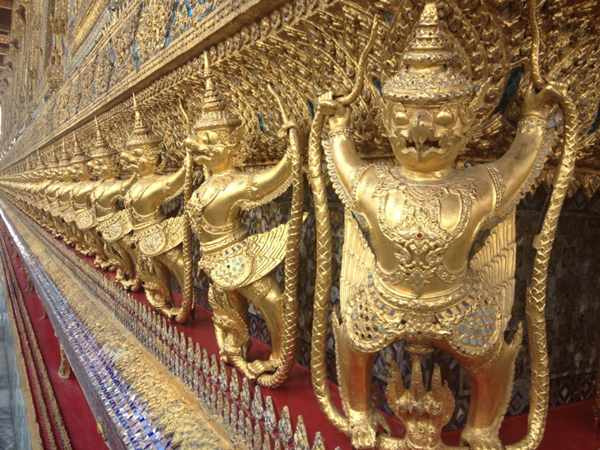



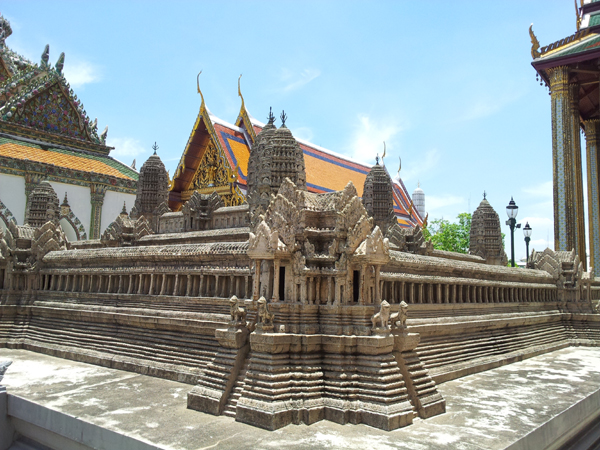

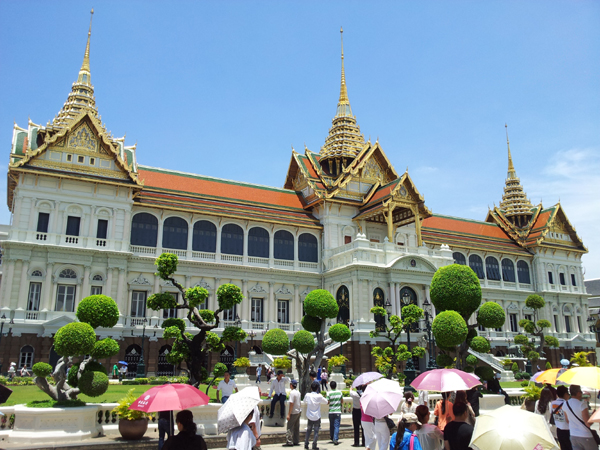

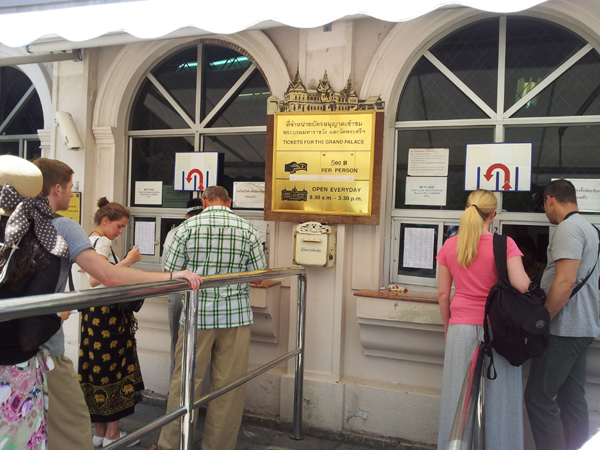

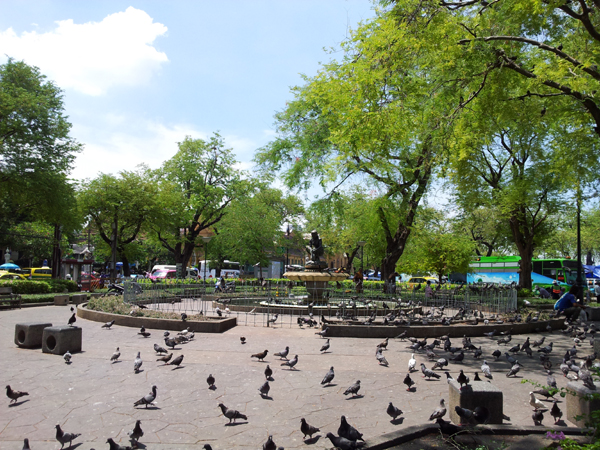
 Contact
Contact